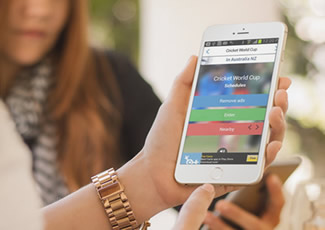
Android App Development
We aim for providing quality services in training Android app developers. Whether you are a firm seeking to improve your employee performance or an educational institution planning to help students to succeed in their careers, we can make a positive impact to the learning needs in many ways.Over the years, we have been providing high quality services and products to its clients and is committed to maintaining the highest quality benchmark within the industry.
Android is one of the most versatile open source mobile OS by Google that is run on a variety of Mobile Devices. Android application uses the versatile Google Android OS platform known for its intuitive and imaginative design, compatibility with multiple networks and the potential for game-changing applications. The Android SDK provides the tools and APIs needed to develop custom applications and we are here to develop the relevant custom applications for you using the Java programming language.
COMPLETE DETAILS OF WHAT YOU LEARN
==========================================
1. What is Android?
1.1. The Android operating system
1.2. Android platform components
1.3. Google Play store and other app stores
2. Android Development Tools
2.1. Android SDK
2.2. Android debug bridge (adb)
2.3. Gradle and the Android plug-in for Gradle
2.4. Android Developer Tools and Android Studio
2.5. Android RunTime (ART)
2.6. Eclipse IDE
3. Security and permissions
3.1. Security concept in Android
3.2. Permission concept in Android
4. Installation of Android Studio
4.1. System requirements
4.2. Requirements for using Linux
4.3. Download eclipse or Android Studio
4.4. Installation of Android Studio
4.5. Configuration
5. Android SDK Manager
5.1. Using the Android SDK manager
5.2. Open the Android SDK manager in Android Studio
5.3. Install selected Android version or library
5.4. Install support library
6. Using Eclipse and JetBrain for Android development
7. Using Android Virtual Devices or real devices for testing
7.1. Android emulator and Android Virtual Device
7.2. Debug certificate and expire date
7.3. Android device emulator shortcuts
7.4. Android AVD
7.5. Speed optimization with GPU rendering
7.8. Using a real Android device for testing
8. E Getting started with Android Studio
8.1. Target
8.2. Create a new Android project
8.3. Review the generated project
8.4. Start your virtual device
9. Parts of a Android application
9.1. Android application
9.2. Android software components
10. Android application components overview
10.1. Activity
10.2. BroadcastReceiver
10.3. Service
10.4. ContentProvider
11. Base user interface components in Android
11.1. Activity
11.2. Fragments
11.3. Views and layout manager
11.4. Device configuration specific layouts
12. Other important Android elements
12.1. Home screen and lock screen widgets
13. The Android manifest
13.1. Configuration of your Android application
13.2. Declaring components in the manifest file
13.3. Permissions
13.4. Android manifest example
14.1 Version and package
14.2. Application and components
14.3. Minimum and target SDK
14.4. Permissions
14.5. Required device configuration
15. Resources
15.2. Example: Defining strings, string arrays, colors and dimensions
15.3. Resource qualifiers
15.4. Resource IDs and R.java
16. Layout resource files
16.1. Activities and layouts
16.2. XML layout files
16.3. Defining IDs
16.4. Good practice: Predefined IDs via a separate file
16.5. Performance considerations with layouts
17. Views
17.1. View class
18. Layout Manager and View Groups
18.1. What is a layout manager?
18.2. Important layout managers
18.3. Layout attributes
18.4. FrameLayout
18.5. LinearLayout
18.6. RelativeLayout
18.7. GridLayout
18.8. ScrollView
19.1. Review generated layout file
19.2. Adjust views
19.3. Validate layout
19.4. Implement button behavior in your activity
19.5. Validate button interaction
19.6. Display text from your EditText field
20. Influence view layout at runtime
20.1. Target of this exercise
20.2. Add radio group and radio buttons to your layout
20.3. Change radio group orientation dynamically
21. Exercise: Create a temperature converter
21.1. Demo application
21.2. Create Project
21.3. Create attributes
21.4. Creating the layout
21.5. Edit view properties
21.6. Create utility class
21.7. Change the activity code
22.1. References to resources in code
22.2. Accessing views from the layout in an activity
22.3. Reference to resources in XML files
22.4. Reference to Android system resources in XML files
23. Assets
23.1. Whats are assets?
23.2. Accessing assets
24.1. Add images to your project
24.2. Add views to your project
24.3. Assign image to your image view
24.4. Replace images via button click
25. Using ScrollView
26. Deployment
26.1. Overview
26.2. Defining software and hardware requirements for the application
26.3. Signing your application for the release
26.4. Export your application via Android Studio
26.5. Export your application via the Eclipse IDE
So you want Android Games?
With Android Marshmellow and stock Browser Updates, great time for Android mobile games. As a Android game development company engineers utilize the platforms' best features for the best user experience in mobile gaming. We are distinct with fine features and benefits like excellent graphic visualization, custom 2D & 3D games, best user interface UX designs, more user friendly game / UX development and our developers expertise bring into shape your ideas and views by using latest tools and technologies.
-
The World of Mobile Arcade Games and Internet Games
- Cricket Games.Get it now
- The Vroom of Car Games
- Racing Games
- Shooting Games with Open GL
- Sudoku Puzzles Get it now
- Rubix Cube Get it now Puzzle games online Get Musical 2018
- Chess Games Get it now
- Monster Truck Games
- Bike Games
- Fighting Games
- Endless Runner Games like Flappy Bird.Get it now
- HTML5 White Tile Web Game
- Snakes and Ladders Type Board Game.Get it now
- Battleship games Get it now
- Other Word Games, Jigsaw Puzzles, Free to Play games, etc
Our Android game development engineers make use of the latest tools and technologies SDKs like Android SDKs, Unity 3D, Open GL etc for Android game development.